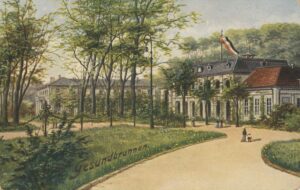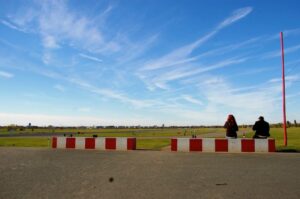Here’s an interesting thing to consider. In 1914, Great Britain went to war, alongside her allies France, the Russian Empire and eventually the USA, against Germany and the Empire of Austria-Hungary. Yet, in the preceding century, the British had fought wars against every one of these allies, and never against Germany. The notion that, in much less than 50 years, the British would occupy a portion of the defeated German capital would have been quite literally unthinkable. Yet, by the end of the Second World War in 1945, it had come to pass, and what followed became a cornerstone of the Cold War.

Carving Order from Chaos
British troops entered the Third Reich’s conquered capital in July 1945, months after the Battle of Berlin, encountering a city devastated almost beyond recognition. Allied bombing and the Soviet assault had destroyed or badly damaged much of the city’s housing stock. Britain was assigned the northwestern quadrant of the city as their occupation zone, encompassing Tiergarten, Charlottenburg, Wilmersdorf, and Spandau—an area of about 165 square kilometers, consisting of the what had been some of the wealthiest and most genteel parts of Hitler’s former capital.
Major General Lewis Owen Lyne was appointed as the first British Military Governor. His mission was clear but daunting: restore order and prevent humanitarian disaster. The British Military Government set up its headquarters in the Olympiastadion complex, repurposing a symbol of Nazi triumphalism for the work of reconstruction, which to my mind at least, is yet another example of Berlin’s ability to showcase irony and tragedy through its architecture.
The administration was able to initial supply around 1050 calories per day per resident, which was enough to sustain life. Just. But it had to do, especially as Britain was itself still suffering enormous economic and food supply problems due to the war.
The Berlin Blockade
By 1948, cooperation among the former Allies was collapsing. When the Western powers introduced the Deutsche Mark in their zones, the Soviet Union retaliated with the Berlin Blockade by sealing off all land and water access to West Berlin, including the British sector.
The Western allies responded decisively, with the Royal Air Force contributing to what became known as the Berlin Airlift. For nearly a year, aircraft flew around the clock into West Berlin, with British planes primarily using RAF Gatow in their zone. By the time the blockade was lifted in May 1949, Allied forces had delivered over 2.3 million tons of supplies.
The airlift became a defining Cold War moment, proving that the Western Allies would not abandon Berlin. It also forged a lasting bond between West Berliners and their British overlords, who increasingly saw their former enemies as their new protectors, keeping them safe from the less-than-loving embrace of Comrade Stalin.
Rebuilding and Renewal
Once the immediate crisis had passed, the British authorities focused on rebuilding civil society. They promoted democratic institutions, encouraged a free press, and supported cultural revival. The British Council played a key role in establishing cultural exchange programs that helped reconnect Berliners with the outside world. The British also supported the work of the newly created Free University of Berlin, which acted to counterbalance the educational institutions of Communist East Berlin, offering eastern students in the early pre-wall days access to western education.
Life in the British Sector
Daily life in the British sector developed its own character. While American cultural influence was more widespread, the British presence was quieter yet still meaningful. English-language instruction gained popularity, military personnel became familiar neighborhood faces, and Anglo-German marriages were not uncommon.
The Kurfürstendamm—partly located in the British zone—emerged as West Berlin’s most fashionable boulevard. Lined with theaters, cafés, and department stores, it stood in deliberate contrast to the austerity of East Berlin and became a symbol of recovery and prosperity. Indeed, if you visit this area of Berlin today, it can feel like the city center itself; and it was, but of West Berlin. It’s worth remembering that this is a Cold War legacy. Prior to that, the Kurfürstendamm was a fashionable and up-and-coming part of town, but not the main and certainly not the historic center of the city. Such are the unexpected legacies of the Cold War.
One distinct British responsibility was the oversight of Spandau Prison. Situated in the British sector, it housed Nazi war criminals sentenced at Nuremberg. After 1966, only Rudolf Hess, an early devotee of Hitler’s and at one time his nominal second in command, remained. He was watched in rotation by guards from each of the four Allied powers until his suicide in 1987.
Reunification and Farewell
The thaw of the late 1980s signaled the end of the Cold War order. Margaret Thatcher’s 1982 visit to West Berlin reaffirmed British support, but winds of change were blowing. When the Berlin Wall fell on November 9, 1989, British troops were on hand as Berliners from both sides embraced, wept, and danced atop the Wall that had once divided them.
German reunification in 1990 ended the Allied occupation of Berlin. The British Berlin Infantry Brigade remained until July 6, 1994, when a formal deactivation ceremony marked the close of nearly 50 years of British military presence and the Union Jack was lowered for the last time.
Echoes of the British Sector: Where to See It Today
If you want to track down some reminders of the British presence in Berlin, it’s possible to see a few sites, although they are neither many not terribly obvious. Here are your best bets:
Olympic Stadium Complex
During the British occupation of Berlin after World War II, the British Military Government established its headquarters within the Olympiastadion complex. Specifically, they took over the Reichssportfeld Administration Building located at Olympischer Platz 3. This building, which was part of the larger Olympic grounds, served as the administrative center for British operations in their sector of the city.The Olympiastadion today features a history trail which has 45 panels in both German and English. You can learn as much as you like about the site’s overall history, including its role during the Nazi era, and its use during the British occupation. This trail offers visitors a comprehensive understanding of the area’s complex history.
RAF Gatow Airfield
Now hosts the Bundeswehr Museum of Military History’s aviation collection, featuring exhibits on the Berlin Airlift and Cold War aviation. It also has some valuable exhibits on the Third Reichs’ Luftwaffe, for those interested.
Brooke Barracks Site
While the complex of buildings have been repurposed, commemorative markers highlight this former Brigade HQ in Spandau.
Spandau Prison Site
The prison was destroyed by the British after Hess died, to prevent the place from become a neo-Nazi shrine. The site now hosts the Spandau Arcaden shopping center. A discreet plaque recalls the prison’s grim legacy.
British War Cemetery at Heerstraße
For those who enjoy visiting cemeteries, this site commemorates British and Commonwealth personnel.
Allied Museum
Located in the former American sector, this museum features excellent exhibits on all Western Allied forces, including Britain’s role in post-war Berlin. Check their website to see when renovations are due to be completed, as in Berlin these dates can change and anything written here might be out of date by the time you read this.
Enjoy tracking down these sites, and others, in the former British sector. The biggest value in doing this is simply that it gets you off the beaten tourist track, and helps you discover parts of the city that most tourists never see, giving you insights into the «real» Berlin of both yesterday and today. And the theme is quite dynamic…what was unthinkable in 1914 felt inevitable and permanent by mid-century, and what was once thought permanent has now vanished into the past, once again feeling unthinkable. Such is Berlin’s noir charm.




